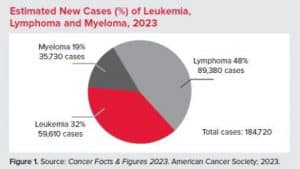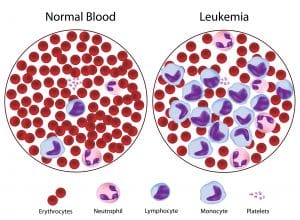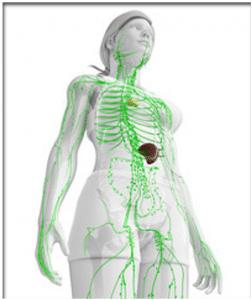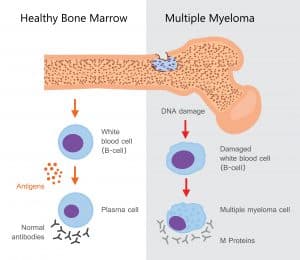September is Blood Cancer Awareness Month

New cases of leukemia, lymphoma and myeloma are expected to account for 9.4 percent of the estimated 1,958,310 new cancer cases that will be diagnosed in the US in 2023.
There has been dramatic improvement in the treatment and outcomes for most blood cancers in the past two decades. Many of these cancers are more common as someone ages, but some leukemias and lymphomas are fairly common in children.

In 2023, 59,610 people are expected to be diagnosed with leukemia in the U.S. alone.
Leukemia is the most common cancer in children younger than 15 years. There are four major types of leukemia: acute myeloid leukemia (AML), which affects myeloid cells and grows quickly; chronic lymphocytic leukemia (CLL), which affects lymphoid cells and grows slowly; acute lymphoblastic leukemia (ALL), which affects lymphoid cells and grows quickly; and chronic myeloid leukemia (CML), which affects myeloid cells and usually grows slowly at first. AML and CLL are the most common types in adults, and ALL is the most common type in children.

Hodgkin lymphoma is usually marked by the presence of a type of cell called the Reed-Sternberg cell in the lymph nodes. Hodgkin lymphoma may also occur in patients who have acquired immunodeficiency syndrome (AIDS).
Non-Hodgkin lymphoma includes a large, diverse group of cancers of immune system cells. Scientists typically categorize them as either slow-growing or aggressive. The most common types of NHL in adults are diffuse large B-cell lymphoma and follicular lymphoma. Both Hodgkin and non-Hodgkin lymphomas can occur in children and adults.
About 89,380 people in the United States (US) are expected to be diagnosed with lymphoma in 2023 (8,830 cases of HL and 80,550 cases of NHL)

Symptoms may not be present or may be non-specific, such as loss of appetite, bone pain, and fever People may experience: Pain in the back or bones, anemia, fatigue, or loss of appetite. Also common: constipation, hypercalcemia, kidney damage, or weight loss.
- An estimated 35,730 new cases of myeloma (19,860 males and 15,870 females) are expected to be diagnosed in the US in 2023.
- An estimated 157,561 people in the United States (US) are living with or in remission from myeloma.
 Childhood and Adolescent Blood Cancers
Childhood and Adolescent Blood Cancers
- An estimated 54,817 children and adolescents younger than 20 years in the US are living with or in remission from leukemia, lymphoma, myeloma, myelodysplastic syndromes (MDS) or myeloproliferative neoplasms (MPNs).
- Leukemia is the most common cancer diagnosed in children and adolescents younger than 20 years and accounts for 25.1 percent of all cancer cases in this age-group.
- From 2015 to 2019, the most recent 5 years for which data are available, leukemia and lymphoma accounted for 37.9 percent of all cancer types in children and adolescents younger than 20 years.
- The most common types of cancer in children and adolescents younger than 20 years are leukemia (25.1 percent), cancers of the brain and other nervous tissue (16.4 percent), non-Hodgkin lymphoma (NHL) (6.7 percent), Hodgkin lymphoma (HL) (6.2 percent), and thyroid cancer (6.2 percent).
- The age-adjusted incidence rate of leukemia and lymphoma in children and adolescents younger than 20 years is 7.4 per 100,000 (leukemia, 4.9 and lymphoma, 2.5).
- Leukemia is the second leading cause of cancer deaths (after cancers of the brain and other nervous tissue) among children and adolescents younger than 20 years. This accounts for 22.7 percent of all cancer-related deaths among this agegroup.
- From 2015-2019, 4.9 percent of all leukemia and lymphoma cases were diagnosed in children and adolescents younger than 20 years.
- From 2015-2019, 3.5 percent of all blood cancers (leukemia, lymphoma, myeloma, MDS and MPNs*) were diagnosed in children and adolescents younger than 20 years.
REFERENCES:
https://www.lls.org/facts-and-statistics/facts-and-statistics-overview

 Childhood and Adolescent Blood Cancers
Childhood and Adolescent Blood Cancers